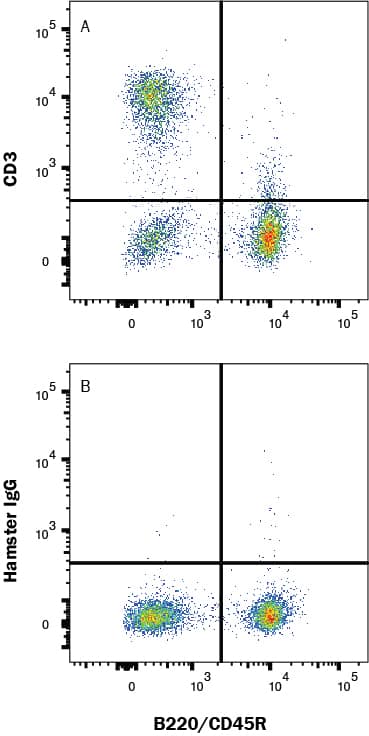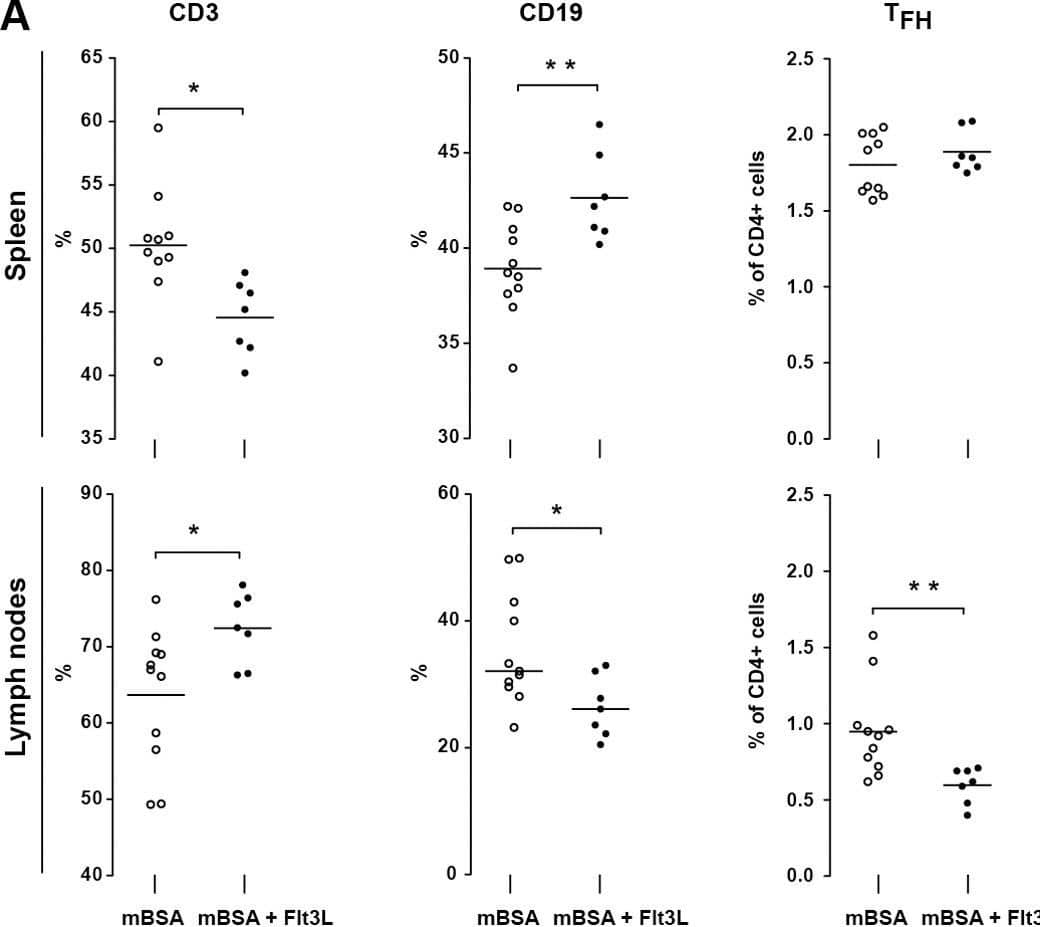Mouse CD3 epsilon Antibody Summary
*Small pack size (-SP) is supplied either lyophilized or as a 0.2 µm filtered solution in PBS.
Applications
Please Note: Optimal dilutions should be determined by each laboratory for each application. General Protocols are available in the Technical Information section on our website.
Scientific Data
 View Larger
View Larger
Detection of CD3 epsilon in mouse splenocytes by Flow Cytometry Mouse splenocytes were stained with Rat Anti-Mouse B220/CD45R PE‑conjugated Monoclonal Antibody (Catalog # FAB1217P) and either (A) Hamster Anti-Mouse CD3 epsilon Monoclonal Antibody (Catalog # MAB484) or (B) Hamster IgG control antibody followed by Allophycocyanin-conjugated Anti-Hamster IgG Secondary Antibody (Catalog # F0121). View our protocol for Staining Membrane-associated Proteins.
 View Larger
View Larger
Mouse CD3 epsilon Antibody Stimulates Cell Proliferation in Mouse T Cells. Hamster Anti-Mouse CD3e Monoclonal Antibody (Catalog # MAB484) stimulates cell proliferation in mouse T cells in a dose-dependent manner, as measured by Resazurin (Catalog # AR002). The ED50 for this effect is typically 0.1-0.6 µg/mL.
 View Larger
View Larger
Detection of CD3 epsilon by Flow Cytometry Flt3L induced changes in splenic and nodal lymphocyte populationsduring mBSA arthritis.A) Frequency of CD3+, CD19+ and TFH (within the CD4+ population) cells in the spleen and draining lymph nodes at day 28. B) Proliferative response of isolated splenocytes following in vitro stimulation with mBSA (25 μg/ml), LPS (10 μg/ml) or anti-CD3 (1 μg/ml). Results are presented as fold increase compared to non-stimulated cells. Data are presented as mean ± SEM and statistical significance was assessed using unpaired t-test. *P<.05, **P<.01. Image collected and cropped by CiteAb from the following open publication (https://pubmed.ncbi.nlm.nih.gov/23349985), licensed under a CC-BY license. Not internally tested by R&D Systems.
Reconstitution Calculator
Preparation and Storage
- 12 months from date of receipt, -20 to -70 °C as supplied.
- 1 month, 2 to 8 °C under sterile conditions after reconstitution.
- 6 months, -20 to -70 °C under sterile conditions after reconstitution.
Background: CD3 epsilon
CD3 is composed of five different polypeptides ranging from 16‑28 kDa that are associated with the T cell receptor (TCR) complex and serve as its signal transducing element. The CD3/TCR complex is expressed on T cells and thymocytes. Binding of immobilized anti-CD3 can cause T cell activation that leads to any of several consequences, depending on the conditions. Activation by anti-CD3 in the presence of IL 2 has been reported to induce cell death, apparently via apoptosis.4 The antibody can be used to induce cytolytic activity against non-specific targets and also to block TCR-mediated cytolytic killing.1 145-2C11 has been used in a variety of studies concerned with allograft rejection and graft-vs host reaction in mice.6, 7
- Leo, O. et al. (1987) Proc. Natl. Acad. Sci. USA 84:1374.
- Portoles, P. et al. (1989) J. Immunol. 142:4169.
- Coulie, P.G. et al. (1991) Eur. J. Immunol. 21:1703.
- Ucker, D.S. J. Meyers and P.S. Obermiller. (1992) J. Immunol. 149:1583.
- Small, M. et al. (1994) J. Immunol. Meth. 167:103.
- Alegre, M.L. et al. (1991) J. Immunol. 146:1184.
- Hendrickson, M. et al. (1995) Transplantation 60:828.
Product Datasheets
Citations for Mouse CD3 epsilon Antibody
R&D Systems personnel manually curate a database that contains references using R&D Systems products. The data collected includes not only links to publications in PubMed, but also provides information about sample types, species, and experimental conditions.
18
Citations: Showing 1 - 10
Filter your results:
Filter by:
-
Role of IL-23 signaling in the progression of premalignant oral lesions to cancer
Authors: B Caughron, Y Yang, MRI Young
PLoS ONE, 2018-04-17;13(4):e0196034.
-
Amnion Epithelial Cells Promote Lung Repair via Lipoxin A4.
Authors: Tan JL, Tan YZ, Muljadi R et al.
Stem Cells Transl Med.
-
High-Fat Diet Alters Immunogenic Properties of Circulating and Adipose Tissue-Associated Myeloid-Derived CD45+DDR2+ Cells
Authors: SJ Sidles, Y Xiong, MRI Young, AC LaRue
Mediators Inflamm., 2019-02-28;2019(0):1648614.
Species: Mouse
Sample Types: Whole Cells
Applications: Bioassay -
IL-23R Signaling Plays No Role in Myocardial Infarction
Authors: E Engelowski, NF Modares, S Gorressen, P Bouvain, D Semmler, C Alter, Z Ding, U Flögel, J Schrader, H Xu, PA Lang, J Fischer, DM Floss, J Scheller
Sci Rep, 2018-11-20;8(1):17078.
Species: Mouse
Sample Types: Whole Cells
Applications: Bioassay -
Filamin A Is Required for Optimal T Cell Integrin-Mediated Force Transmission, Flow Adhesion, and T Cell Trafficking
Authors: T Savinko, C Guenther, LM Uotila, M Llort Asen, S Yao, S Tojkander, SC Fagerholm
J. Immunol., 2018-03-26;0(0):.
Species: Mouse
Sample Types: Whole Cells
Applications: Functional Assay -
Role of a novel immune modulating DDR2-expressing population in silica-induced pulmonary fibrosis
Authors: LT McDonald, SD Johnson, DL Russell, MRI Young, AC LaRue
PLoS ONE, 2017-07-10;12(7):e0180724.
Species: Mouse
Sample Types: Whole Cells
Applications: Bioassay -
mTORC2 controls Th9 polarization and allergic airway inflammation
Authors: H Chen, L Zhang, P Wang, H Su, W Wang, Z Chu, L Zhang, X Zhang, Y Zhao
Allergy, 2017-03-29;0(0):.
Species: Mouse
Sample Types: Whole Cells
Applications: Functional Assay -
HTLV-1 bZIP Factor Enhances T-Cell Proliferation by Impeding the Suppressive Signaling of Co-inhibitory Receptors
Authors: H Kinosada, JI Yasunaga, K Shimura, P Miyazato, C Onishi, T Iyoda, K Inaba, M Matsuoka
PLoS Pathog, 2017-01-03;13(1):e1006120.
-
Amnion cell-mediated immune modulation following bleomycin challenge: controlling the regulatory T cell response
Authors: Jean L Tan, Siow T Chan, Camden Y Lo, James A Deane, Courtney A McDonald, Claude CA Bernard et al.
Stem Cell Research & Therapy
-
Developmental heterogeneity in DNA packaging patterns influences T-cell activation and transmigration.
Authors: Gupta S, Marcel N, Talwar S, Garg M, R I, Perumalsamy L, Sarin A, Shivashankar G
PLoS ONE, 2012-09-05;7(9):e43718.
Species: Mouse
Sample Types: Whole Cells
Applications: Functional Assay -
Naive and activated T cells display differential responsiveness to TL1A that affects Th17 generation, maintenance, and proliferation.
Authors: Jones GW, Stumhofer JS, Foster T, Twohig JP, Hertzog P, Topley N, Williams AS, Hunter CA, Jenkins BJ, Wang EC, Jones SA
FASEB J., 2010-09-08;25(1):409-19.
Species: Mouse
Sample Types: Whole Cells
Applications: Bioassay -
Loss of CD4+ T cell IL-6R expression during inflammation underlines a role for IL-6 trans signaling in the local maintenance of Th17 cells.
Authors: Jones GW, McLoughlin RM, Hammond VJ, Parker CR, Williams JD, Malhotra R, Scheller J, Williams AS, Rose-John S, Topley N, Jones SA
J. Immunol., 2010-01-18;184(4):2130-9.
Species: Mouse
Sample Types: Whole Cells
Applications: Neutralization -
Phosphatidylinositol-3-OH kinase and nutrient-sensing mTOR pathways control T lymphocyte trafficking.
Authors: Sinclair LV, Finlay D, Feijoo C, Cornish GH, Gray A, Ager A, Okkenhaug K, Hagenbeek TJ, Spits H, Cantrell DA
Nat. Immunol., 2008-04-06;9(5):513-21.
Species: Mouse
Sample Types: Whole Cells
Applications: Functional Assay -
Protection of CD8+ T cells from activation-induced cell death by IL-18.
Authors: Li W, Kashiwamura S, Ueda H, Sekiyama A, Okamura H
J. Leukoc. Biol., 2007-03-30;82(1):142-51.
Species: Mouse
Sample Types: Whole Cells
Applications: Functional Assay -
Evidence for a role for notch signaling in the cytokine-dependent survival of activated T cells.
Authors: Bheeshmachar G, Purushotaman D, Sade H, Gunasekharan V, Rangarajan A, Sarin A
J. Immunol., 2006-10-15;177(8):5041-50.
Species: Mouse
Sample Types: Whole Cells
Applications: Functional Assay -
Tristetraprolin down-regulates IL-2 gene expression through AU-rich element-mediated mRNA decay.
Authors: Ogilvie RL, Abelson M, Hau HH, Vlasova I, Blackshear PJ, Bohjanen PR
J. Immunol., 2005-01-15;174(2):953-61.
Species: Mouse
Sample Types: Whole Cells
Applications: Functional Assay -
Dopamine, through the extracellular signal-regulated kinase pathway, downregulates CD4+CD25+ regulatory T-cell activity: implications for neurodegeneration.
Authors: Kipnis J, Cardon M, Avidan H, Lewitus GM, Mordechay S, Rolls A, Shani Y, Schwartz M
J. Neurosci., 2004-07-07;24(27):6133-43.
Species: Mouse
Sample Types: Whole Cells
Applications: Functional Assay -
Superoxide Dismutase 3 Controls the Activation and Differentiation of CD4+T Cells
Authors: Gaurav Agrahari, Shyam Kishor Sah, Chul Hwan Bang, Yeong Ho Kim, Tae-Yoon Kim
Frontiers in Immunology
FAQs
No product specific FAQs exist for this product, however you may
View all Antibody FAQsReviews for Mouse CD3 epsilon Antibody
There are currently no reviews for this product. Be the first to review Mouse CD3 epsilon Antibody and earn rewards!
Have you used Mouse CD3 epsilon Antibody?
Submit a review and receive an Amazon gift card.
$25/€18/£15/$25CAN/¥75 Yuan/¥2500 Yen for a review with an image
$10/€7/£6/$10 CAD/¥70 Yuan/¥1110 Yen for a review without an image





